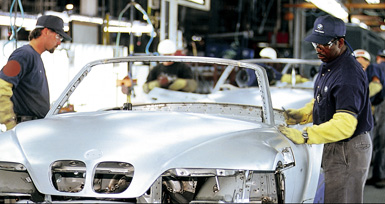
Iran Automakers Produce 1.25m Vehicles in Last Fiscal

 Renault sold 36,000 Sanderos in the previous Iranian year.
Renault sold 36,000 Sanderos in the previous Iranian year.
Iran's state-owned and private carmakers missed their production target by 50,000 units in the last fiscal that ended on March 20.
According to the latest data released by local automotive website Asre Khodro, total car production hit 1.25 million during the 12 months.
However, the industry saw a 40.7% growth in auto production year-on-year, according to the Ministry of Industries, Mining and Trade.
Missing of the target should worry carmakers as earlier in the year they had anticipated sales would exceed their initial estimates.
However, production delays during the year that just ended put off many from purchasing a new car for fear of getting a raw deal if something better comes along from one of the several companies entering the market, for instance Renault.
Meanwhile, logistical issues have also dogged carmakers rushing to bring out new vehicles.
In one example last autumn Renault announced it was planning to sell the Indian-developed Renault Kwid to the local market, however, no word has been heard since the initial announcement.
The company local director, Payman Kargar, said the car would be competitively priced at the lower-end of the local offerings, around 300 million rials ($7800) placing it in competition with SAIPA's Tiba model.
Another possible issue for the car companies is the ongoing belt tightening by car buyers, with many still put off by high interest rates against hire- purchase schemes.
Car companies usually charge over and above the rate of inflation for car purchases.
Just before the end of the year, the largest car group, Iran Khodro (IKCO) announced it had begun production of a Peugeot 2008 crossover as part of its joint venture with the PSA Group’s Peugeot brand.
The car is likely to cost more than 900 million rials ($24,000), which is some 20% higher than its equivalent vehicle sold in Europe.
In this year Iran hopes to produce some 1.5 million vehicles by March 2018.


Trump weighs using $2 billion in CHIPS Act funding for critical minerals

Codelco cuts 2025 copper forecast after El Teniente mine collapse

Electra converts debt, launches $30M raise to jumpstart stalled cobalt refinery

Barrick’s Reko Diq in line for $410M ADB backing

Abcourt readies Sleeping Giant mill to pour first gold since 2014

Nevada army depot to serve as base for first US strategic minerals stockpile

SQM boosts lithium supply plans as prices flick higher

Viridis unveils 200Mt initial reserve for Brazil rare earth project

Tailings could meet much of US critical mineral demand – study

Kyrgyzstan kicks off underground gold mining at Kumtor

Kyrgyzstan kicks off underground gold mining at Kumtor

KoBold Metals granted lithium exploration rights in Congo

Freeport Indonesia to wrap up Gresik plant repairs by early September

Energy Fuels soars on Vulcan Elements partnership

Northern Dynasty sticks to proposal in battle to lift Pebble mine veto

Giustra-backed mining firm teams up with informal miners in Colombia

Critical Metals signs agreement to supply rare earth to US government-funded facility

China extends rare earth controls to imported material

Galan Lithium proceeds with $13M financing for Argentina project

Kyrgyzstan kicks off underground gold mining at Kumtor

Freeport Indonesia to wrap up Gresik plant repairs by early September

Energy Fuels soars on Vulcan Elements partnership

Northern Dynasty sticks to proposal in battle to lift Pebble mine veto

Giustra-backed mining firm teams up with informal miners in Colombia

Critical Metals signs agreement to supply rare earth to US government-funded facility

China extends rare earth controls to imported material

Galan Lithium proceeds with $13M financing for Argentina project

Silver price touches $39 as market weighs rate cut outlook

















